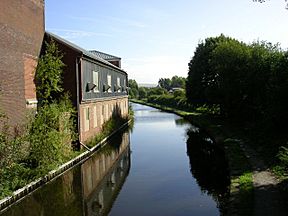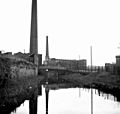Ashton Canal facts for kids
Quick facts for kids Ashton Canal |
|
|---|---|

The Ashton Canal at Droylsden
|
|
| Specifications | |
| Length | 6 miles (9.7 km) |
| Maximum boat length | 70 ft 0 in (21.34 m) |
| Maximum boat beam | 7 ft 0 in (2.13 m) |
| Locks | 18 |
| Status | Navigable |
| Navigation authority | Canal & River Trust |
| History | |
| Principal engineer | Benjamin Outram |
| Date of act | 1792 |
| Date of first use | 1796 |
| Date completed | 1797 |
| Date closed | 1961 |
| Date restored | 1974 |
| Geography | |
| Start point | Ashton-under-Lyne |
| End point | Ducie St Jn, Manchester |
| Branch(es) | Hollinwood Branch Canal, Stockport Branch, Islington Branch Canal |
| Connects to | Huddersfield Narrow Canal, Peak Forest Canal, Rochdale Canal |
The Ashton Canal is a historic waterway in Greater Manchester, England. It's a great place to explore by boat or on foot!
Route
The Ashton Canal starts in central Manchester. It connects to the Rochdale Canal at Ducie Street Junction. From there, it travels about 6.7 miles (10.8 km) through 18 special water lifts called locks. These locks help boats move up and down hills! Along the way, the canal passes through towns like Ancoats, Droylsden, and Audenshaw. It ends in Ashton-under-Lyne, where it meets the Huddersfield Narrow Canal. Near Bradford, you can even see the area where the 2002 Commonwealth Games were held!
The Ashton Canal also links up with the Peak Forest Canal. This connection happens at Dukinfield Junction/Portland Basin. Here, a short section of the canal crosses the River Tame on a special bridge called the Tame Aqueduct.
In the past, there were four other important branch canals connected to the Ashton Canal:
- The Islington Branch Canal in Ancoats.
- The Stockport Branch Canal from Clayton to Stockport.
- The Hollinwood Branch Canal from Fairfield to Hollinwood.
- The Fairbottom Branch Canal, which was a branch of the Hollinwood Canal.
Many of the canal's locks are now protected as listed buildings. This means they are important historical structures.
History
The idea for the Ashton Canal became law in 1792. It was built to transport coal from areas like Oldham and Ashton-under-Lyne to Manchester. The first part of the canal opened in 1796. Other sections to Heaton Norris and Fairbottom followed in 1797. Even though there were plans to connect it to the Rochdale Canal, it first opened as a separate waterway.
Benjamin Outram, a skilled engineer, helped finish the last part of the canal. This section included the amazing Store Street Aqueduct. This bridge was built at a 45-degree angle, which was very unusual for its time. It is thought to be the first major bridge of its kind in Britain and is still used today!
The canal was fully connected by 1798. However, other canals it was meant to link with, like the Rochdale Canal and the Huddersfield Narrow Canal, were not yet finished. It took another ten years for the Huddersfield Narrow Canal to connect to Yorkshire and the east coast.
Because it only had local trade at first, the canal faced money problems. It didn't start making a profit until 1806. Later, new ways of transport like railways and roads caused the canal to lose business. By 1945, boats stopped using it for long journeys. Traffic on the smaller branch canals ended even earlier, in the 1930s.
After 1947, the canal was no longer used for transport. By 1958, all boat traffic had stopped. The canal was not looked after, and by 1961, it was in bad shape and couldn't be used by boats anymore.
However, in 1983, the Ashton Canal was officially recognized as an important waterway. This meant it would be looked after and improved for people to enjoy.
Leisure Use
Many people wanted to see the Ashton Canal open again. Groups like the Inland Waterways Association and the Peak Forest Canal Society worked hard to make this happen. Volunteers helped clear sections of the canal in 1968. Thanks to their efforts and local support, the canal was restored and reopened on April 1, 1974.
The reopening of the Ashton Canal, along with the Peak Forest Canal, created the famous Cheshire Ring. This is a popular route for boaters that takes about a week to complete. It circles through much of east Cheshire. The Ashton Canal is also part of other popular boating routes, like the South Pennine Ring and the Outer Pennine Ring.
In the past, there were sometimes reports of problems along the Ashton Canal, like things being stolen from boats. This made some boaters travel in groups. Today, the canal is much more valued by the communities it passes through. While some boaters still suggest being careful, many of the old stories about problems are just that—old stories. However, it's always good to be aware of your surroundings.
Sometimes, rubbish like shopping trolleys or rocks can block the locks. But workers from the Canal & River Trust usually clear these problems quickly. Portland Basin is a good place to stop overnight after going through the Ashton locks.
There are ongoing efforts to restore the Hollinwood Branch and Stockport Branches of the canal. This would open up even more waterways for people to enjoy!
Listed Structures
Many structures along the canal are protected as Grade II listed buildings. This means they are historically important. These include:
- Locks numbers 1-3, 6-15 & 18
- Bridges numbers 4, 5, 9 & 16
- Lock Keepers Cottages at locks numbers 2 & 7
- Towpath Bridge over junction with Islington Branch Canal
- Towpath Bridge over junction with Stockport Branch Canal
- Former Packet Boathouse next to bridge number 16
- Former Tollhouse next to lock number 18 (Fairfield Top Lock)
- Mill Building on the south bank east of Hope Works
Image Gallery
See Also
| Point | Coordinates (Links to map resources) |
OS Grid Ref | Notes |
|---|---|---|---|
| Dukinfield Junction | 53°28′57″N 2°05′59″W / 53.4824°N 2.0996°W | SJ934984 | Huddersfield Narrow & Peak Forrest Canals |
| Top of Clayton Locks (No.16) | 53°28′42″N 2°09′54″W / 53.4784°N 2.1650°W | SJ891979 | Flight of 9 locks |
| Jn with derelict Stockport Branch | 53°28′50″N 2°10′41″W / 53.4805°N 2.1780°W | SJ882982 | Clayton lock No.11 |
| Bottom of Clayton Locks (No.8) | 53°28′58″N 2°11′16″W / 53.4827°N 2.1879°W | SJ876984 | |
| Top of Beswick Locks (No.7) | 53°29′09″N 2°11′51″W / 53.4858°N 2.1974°W | SJ869988 | Flight of 4 locks |
| Bottom of Beswick Locks (No.4) | 53°29′07″N 2°12′16″W / 53.4854°N 2.2045°W | SJ865987 | |
| Top of Ancoats Locks (No.3) | 53°28′53″N 2°13′13″W / 53.4814°N 2.2203°W | SJ854983 | Flight of 3 locks |
| Ducie Street Junction | 53°28′48″N 2°13′49″W / 53.4799°N 2.2303°W | SJ848981 | Jn with Rochdale Canal |
Images for kids













